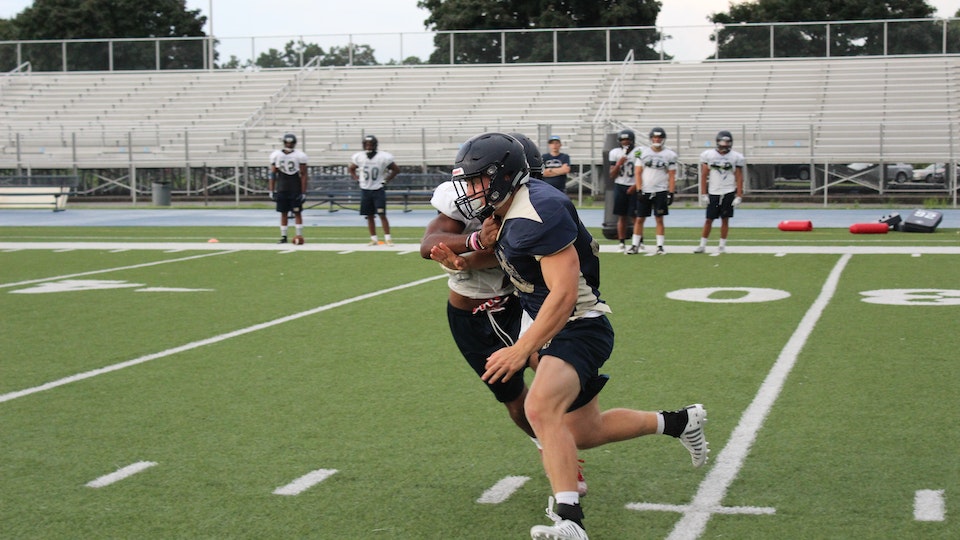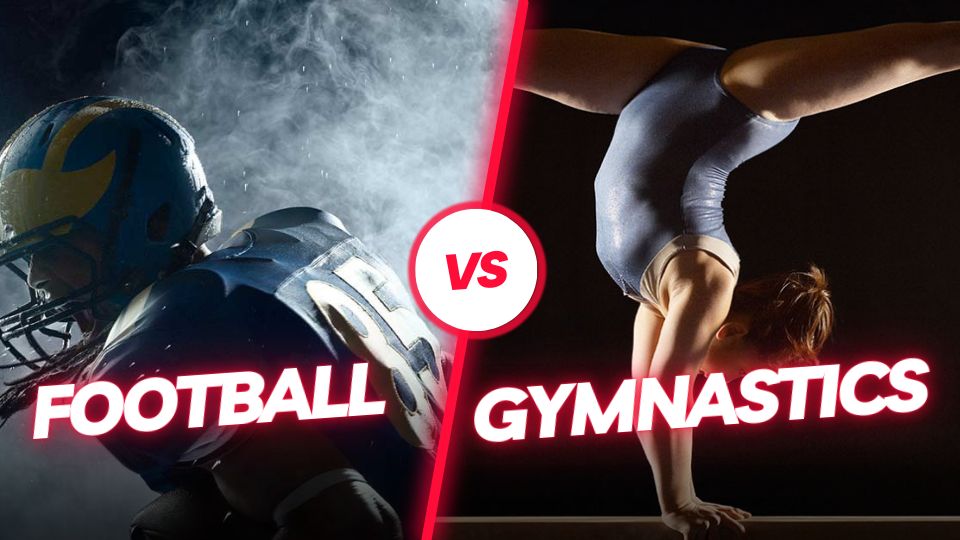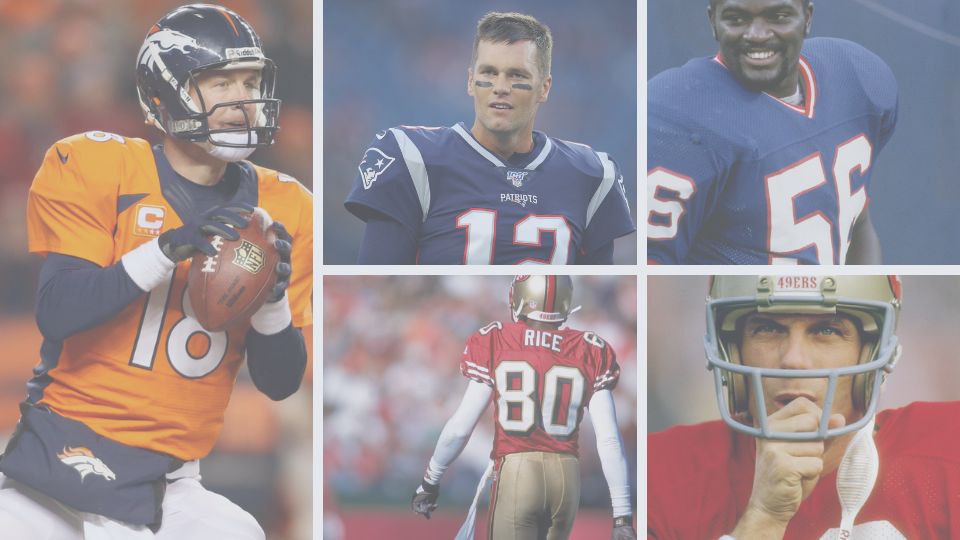Gymnastics and football are two dynamic and challenging sports with global recognition and cultural significance. Both have garnered respect and a massive fan following due to their inclusion in prestigious events worldwide.
This article explores various factors, including physical demands, technical complexity, mental challenges, and subjective perspectives of each sport. Moreover, it will compare the difficulty levels of gymnastics and football by delving into each sport’s unique demands and intricacies to answer the ultimate question: “Is gymnastics harder than football?”
Is Gymnastics Harder Than Football? Comparing Physical Demands
Gymnast’s Intensive Training and Conditioning

When gymnasts commit to gymnastics, they also commit to undergo rigorous training. The practice would include a choreography routine and technical workouts to succeed in gymnastics. In terms of that, is gymnastics harder than football? Perhaps yes.
Strength training is crucial in this sport, concentrating on core, upper body, and lower body strength to execute and maintain control during challenging routines. Gymnasts also have to acquire maximum flexibility to achieve difficult positions.
Injury prevention is a top priority in gymnastics training. Coaches implement warm-ups, cool-downs, and techniques during training for safe landings due to the sport’s high-impact movements.
Gymnastics training lasts several hours daily, six days a week, to hone gymnasts’ skills. Performing demanding tricks like flips, twists, and intricate routines requires years of practice, proving that mental and physical resilience is essential for gymnasts.
Football’s Physical Demands and Challenges

NFL players face numerous physical demands and challenges due to the highly intense sport. Since NFL matches are fast-paced and require players to perform at maximum effort throughout the game, players must sprint and exert high physical effort in every play.
NFL games require physical contact, often leading to injuring players in collisions, tackles, and blocks. Players must deal with the potential for injuries and focus on prevention and rehabilitation to stay in the league.
Moreover, players must maintain consistent physical performance and stamina throughout the game’s four quarters. Strength training, cardiovascular workouts, and agility drills achieve this goal. Moreover, NFL players face an excessive risk of depression, confusion, aggression, and other mental health challenges.
Keeping all of this in mind, there’s no doubt that NFL players must be physically and mentally prepared to meet the challenges and needs of the sport to shine at the professional level.
Comparing The Physical Demands

The question is gymnastics harder than football is answered by the simple fact that both sports place physical demands on athletes. In gymnastics, common injuries like stress fractures and ligament tears are often caused by repetitive training and high-impact movements.
Meanwhile, in NFL games, common injuries include concussions, sprains, and muscle strains. Moreover, physical contact, tackles, and collisions in football can lead to concussions, influencing the brain’s function.
Proper warm-ups, cool-downs, and injury-prevention strategies are vital in gymnastics. Similarly, athletes receive immediate medical attention for injuries and undergo rehabilitation programs in football.
Both gymnasts and footballers must manage injuries and focus on recovery to maintain their long-term health and performance. Preventative measures and proper rehabilitation are compulsory in mitigating the consequence of injuries on athletes’ bodies.
Technical Skills Involved in Gymnastics & Football
Key Gymnastics Technical Skills

Gymnastics is a highly demanding sport in terms of technicality and physical exertion. Aspiring gymnasts start training at a young age, often between 5 and 8, to develop the necessary foundation of strength, flexibility, and basic skills.
Every gymnast requires skills for various performances, such as tumbling passes, bar routines, beam maneuvers, and floor exercises. In Gymnastics, execution counts the most for the scoring system, and deductions can be made over the slightest mistake, such as bent knees, flexed feet, balance errors, etc.
Training for gymnastics is technical and includes developing strength, flexibility, and technique and mastering progressively more complex skills and routines. This sport has a high risk of injuries, so training must be balanced with proper rest and injury prevention measures.
Football’s Essential Technical Skills

The NFL is the leading professional football league in the USA, and many young athletes aspire to participate. However, it is not a piece of cake, as NFL players need specific technical skills, and mastering it can significantly impact a player’s chances of being selected to play in the league.
These essential skills include speed and strength, vital for quick decision-making, outpacing opponents, and withstanding physicality while avoiding injuries. Additionally, balance and agility are necessary for making precise movements. Good coordination, endurance, risk assessment, and the ability to handle pressure are also crucial in excelling in the sport.
Demonstrating proficiency in these areas increases NFL players’ chances to make their mark in the grand NFL.
Skill Development in Gymnastics vs. Football
Football and gymnastics require a mix of technical skills, so asking if gymnastics is harder than football is unfair. However, football demands strategic planning and physical prowess, while gymnastics requires accuracy, strength, and balance.
The learning curve in football is constant. In this game, beginners can acquire basic skills, but advanced techniques require years of experience and exposure to competitive settings. On the other hand, in gymnastics, a structured advancement of skills builds upon each other and demands years of dedicated training.
In gymnastics, perfecting execution is essential, and gymnasts have to spend years brushing up their skills starting from a young age. In NFL football, practice and experience are crucial to enhancing skills and decision-making under pressure.
Mastering high-level gymnastics skills is highly challenging due to the physical demands and accuracy required. In disparity, mastering football techniques involves comprehending intricate tactics and competing in events.
Is Gymnastics Harder Than Football? Let’s Find Out Through Training and Preparation
The Gymnastics Craft: Coaches, Drills, and Competition Preparation

Gymnastics training demands multiple intense practice sessions per week. The frequency of these practices depends on the gymnast’s level and objectives. Usually, gymnastics training methods include skill drills, strength conditioning, flexibility exercises, routine practice, conditioning circuits, and mental training.
Gymnasts require professional training from coaches in learning technicalities, personalized skills, and guidance for competition strategy. Training facilities are also designed to accommodate gymnastics needs with appropriate safety measures.
Athletes must perform repetitive drills to improve muscle memory and perfect choreography. Moreover, this practice ensures that gymnastics perform flawlessly under pressure.
Gymnasts must also undergo unique preparation for competitions involving tapering training intensity, mental preparation, visualization, and strategic planning with coaches. Additionally, gymnasts must go the extra mile to manage their diet, rest, and injury prevention to optimize physical and mental health for the best performance.
Football Training Regimens: Coaching, Fitness, and Tactical Preparation

In the NFL, players must devote themselves to rigorous training and weekly matches throughout the regular season. However, Tuesdays are strictly no training days, as players need to prioritize their rest too.
In this sport, training is grueling, often starting early and extending late, with some adjustments for away games or injury rehabilitation. In fact, the regular season lasts 17 weeks, followed by playoffs leading to the Super Bowl.
Once the season is over, players get a few weeks of recovery time to rest their minds and body. So they can gear up for the next season and be a part of Organized Team Activities (OTAs). NFL football demands exceptional persistence and dedication due to its intense physical demands so that players can maintain peak performance.
Contrasting the Training & Preparation Demands of Gymnastics and Football
When it comes to gymnastics, it demands tremendous dedication, with hours and hours of training and constant advancement to pilot intricate routines. Gymnasts must commence training at a young age and take the risk of injuries.
Meanwhile, NFL football also requires dedication, with consistent training to maintain prime physical shape and hone skills. Success in the NFL requires physical power, strategy, and mental grit.
Gymnasts have structured and disciplined life, concentrating on embodiment and accuracy, while footballers share a team-oriented lifestyle. NFL Footballers’ life includes traveling for games, adapting to adaptability, and playing under inconsistent conditions.
But, in short, both sports need discipline, skillful judgment, and resilience from players to succeed. So, is gymnastics harder than football? No, not really, as they both are challenging in their own ways.
Success and Achievement
Honoring Gymnastic Icons and Their Remarkable Achievements

Throughout history, Gymnastics has witnessed many remarkable athletes. Here are some noteworthy gymnasts:
- Nadia Comăneci received a perfect 10 score at the Olympics and secured five gold medals.
- Olga Korbut is known as “The Sparrow from Minsk” as she won four gold and two silver medals at the Summer Olympics.
- Simone Biles won seven Olympic medals, earning her celebrated athlete status.
- Kohei Uchimura is the greatest gymnast of all time, with three golds and four silver medals in his career.
- Larisa Latynina is a record-setter, earning an astonishing 18 Olympic medals.
Celebrating Football Legends and Their Impact on the Sport

Throughout history, NFL has witnessed many incredible athletes. Here are some outstanding footballers:
- Tom Brady is a 7-time Super Bowl champion, considered one of the greatest quarterbacks.
- Peyton Manning is a 2-time Super Bowl winner.
- Jerry Rice is the most excellent wide receiver, a 3-time Super Bowl champion with numerous records.
- Lawrence Taylor is a dominant linebacker and a 2-time Super Bowl winner with the Giants.
- Joe Montana is a 4-time Super Bowl champion renowned for clutch performances.
Contrasting Measures of Success and Recognition in Gymnastics and Football
In gymnastics and NFL games, success and recognition depend on individual and team achievements. However, success’s definition varies between the two sports without asking – is gymnastics harder than football?
In gymnastics, success is measured by individual achievements such as medals won in significant competitions, high scores from judges, and breaking records with exceptional performances.
In the NFL, success is primarily determined by team achievements such as winning the Super Bowl, conference championships, and division titles. Additionally, individual awards like the MVP (Most Valuable Player) recognize exceptional players for their outstanding performances throughout the season.
Overall, while both sports share a focus on individual talent and team success, the criteria and significance of success and recognition differ.
Subjective Factors
Factors Influencing Individual Perceptions of Sport Difficulty

Individual preferences and personalities significantly draw athletes towards a certain sport. Passionate people don’t ask themselves – is gymnastics harder than football? They just go where passion takes them.
Moreover, specific physical or mental qualities can make one sport more appealing to individuals, shaping their opinions on the level of challenge it offers.
Cultural factors, exposure to sports, and personal experiences can influence athletes’ stances. For instance, prior involvement in specific activities can influence how they approach certain sports.
Welcoming athletes’ diverse viewpoints improve sports as a field. Moreover, it helps in celebrating each athlete’s unique strengths.
Embracing the Unique Challenges of Gymnastics and Football
Comparing the difficulty of gymnastics and football is inherently subjective due to the distinct nature of these sports. Each presents unique challenges and requires different skill sets.
Gymnastics demands extraordinary precision, strength, and flexibility, while football relies on teamwork, tactical awareness, and physical endurance.
Both sports demand immense dedication from athletes to achieve success. Thus, rather than comparing the difficulty of different sports, let us celebrate the diversity and greatness of both gymnastics and football.
Conclusion
In exploring the famous question, “Is gymnastics harder than football?” we examined various factors of each sport and discovered that the difficulty of gymnastics and football cannot be universally compared. Each of the two demands extraordinary skill sets, and individual perspectives play a significant role in assessing difficulty.
Rather than pitting these two sports against each other, we should respect and celebrate the challenges and individuality of both sports. Gymnastics showcases artistry and athleticism, while football illustrates teamwork and tactics. Each sport imparts invaluable life lessons such as discipline, determination, and commitment. Moreover, inspiring young athletes all over the world.
